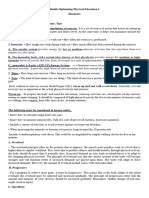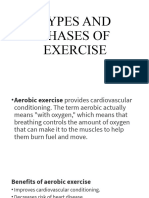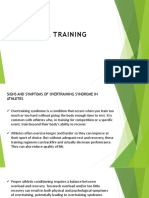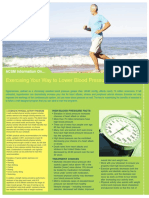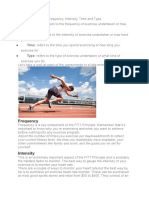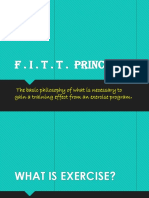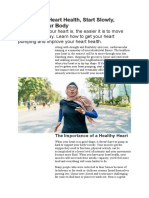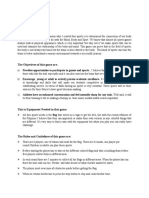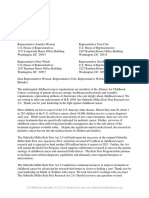0 ratings0% found this document useful (0 votes)
Understanding Heart Rate & Exercise: Intensity
Understanding Heart Rate & Exercise: Intensity
Uploaded by
Angelica VinluanModerate exercise intensity is recommended for most adults and includes activities that raise heart rate to 50-70% of maximum. Vigorous intensity raises heart rate to 70-85% of maximum. Intensity can be measured by perceived exertion levels like breathlessness or heart rate. Target heart rates are calculated based on age and provide zones for moderate and vigorous exercise. Interval training with periods of higher intensity is effective for fitness and weight loss.
Copyright:
© All Rights Reserved
Available Formats
Download as PPTX, PDF, TXT or read online from Scribd
Download as pptx, pdf, or txt
Understanding Heart Rate & Exercise: Intensity
Understanding Heart Rate & Exercise: Intensity
Uploaded by
Angelica Vinluan0 ratings0% found this document useful (0 votes)
Moderate exercise intensity is recommended for most adults and includes activities that raise heart rate to 50-70% of maximum. Vigorous intensity raises heart rate to 70-85% of maximum. Intensity can be measured by perceived exertion levels like breathlessness or heart rate. Target heart rates are calculated based on age and provide zones for moderate and vigorous exercise. Interval training with periods of higher intensity is effective for fitness and weight loss.
Original Title
Heart-Rate-and-Exercise
Copyright
© © All Rights Reserved
Available Formats
PPTX, PDF, TXT or read online from Scribd
Share this document
Did you find this document useful?
Is this content inappropriate?
Moderate exercise intensity is recommended for most adults and includes activities that raise heart rate to 50-70% of maximum. Vigorous intensity raises heart rate to 70-85% of maximum. Intensity can be measured by perceived exertion levels like breathlessness or heart rate. Target heart rates are calculated based on age and provide zones for moderate and vigorous exercise. Interval training with periods of higher intensity is effective for fitness and weight loss.
Copyright:
© All Rights Reserved
Available Formats
Download as PPTX, PDF, TXT or read online from Scribd
Download as pptx, pdf, or txt
0 ratings0% found this document useful (0 votes)
Understanding Heart Rate & Exercise: Intensity
Understanding Heart Rate & Exercise: Intensity
Uploaded by
Angelica VinluanModerate exercise intensity is recommended for most adults and includes activities that raise heart rate to 50-70% of maximum. Vigorous intensity raises heart rate to 70-85% of maximum. Intensity can be measured by perceived exertion levels like breathlessness or heart rate. Target heart rates are calculated based on age and provide zones for moderate and vigorous exercise. Interval training with periods of higher intensity is effective for fitness and weight loss.
Copyright:
© All Rights Reserved
Available Formats
Download as PPTX, PDF, TXT or read online from Scribd
Download as pptx, pdf, or txt
You are on page 1/ 13
Understanding Heart Rate & Exercise
• Exercise intensity: How to measure it?
• Get the most from your workouts by knowing how to gauge your exercise
intensity.
• When you exercise, are you working hard or hardly working? Exercising at the
correct intensity can help you get the most out of your physical activity — making
sure you're not pushing too hard or too little. Here's a look at what exercise
intensity means, and how to maximize your workout.
• Choosing your exercise intensity
• How hard should you be exercising?
• The Department of Health and Human Services recommends these exercise
guidelines for most healthy adults:
• Aerobic activity. Get at least 150 minutes a week of moderate aerobic
activity — such as brisk walking, swimming or mowing the lawn —
or 75 minutes a week of vigorous aerobic activity — such as running
or aerobic dancing. You can also do a combination of moderate and
vigorous activity. It's best to do this over the course of a week. You can
achieve more health benefits if you ramp up your exercise to 300
minutes or more of moderate aerobic activity a week.
• Even small amounts of physical activity are helpful, and accumulated
activity throughout the day adds up to provide health benefits.
• Strength training. Do strength training for all major muscle groups at
least twice a week. Consider free weights, weight machines or
activities that use your own body weight — such as rock climbing or
heavy gardening. Or try squats, planks or lunges. Aim to do a single
set of each exercise, using a weight or resistance level heavy enough
to tire your muscles after about 12 to 15 repetitions.
• Your exercise intensity must generally be at a moderate or vigorous
level for maximum benefit. For weight loss, the more intense or longer
your activity, the more calories you burn.
• Balance is still important. Overdoing it can increase your risk of
soreness, injury and burnout. Start at a light intensity if you're new to
exercising. Gradually build up to a moderate or vigorous intensity.
• Consider your reasons for exercising. Do you want to
improve your fitness, lose weight, train for a competition or
do a combination of these? Your answer will help determine
the appropriate level of exercise intensity.
• Be realistic and don't push yourself too hard, too fast. Fitness
is a lifetime commitment, not a sprint to a finish line. Talk to
your doctor if you have any medical conditions or you're not
sure how intense you should exercise.
Understanding exercise intensity
• When you're doing aerobic activity, such as walking or biking, exercise
intensity correlates with how hard the activity feels to you. Exercise
intensity is also shown in your breathing and heart rate, whether you're
sweating, and how tired your muscles feel.
• There are two basic ways to measure exercise intensity:
• How you feel. Exercise intensity is a subjective measure of how hard
physical activity feels to you while you're doing it — your perceived
exertion. Your perceived exertion level may be different from what someone
else feels doing the same exercise. For example, what feels to you like a
hard run can feel like an easy workout to someone who's more fit.
• Your heart rate. Your heart rate offers a more objective look at exercise
intensity. In general, the higher your heart rate during physical activity, the
higher the exercise intensity.
• Perceived exertion may not always be similar to your heart rate level,
and it depends on the individual. But it can be a general guide to
measure your exertion level. If you think you're working hard, your
heart rate is probably higher than usual.
• You can use either way of gauging exercise intensity. If you like
technology, you can check your heart rate with an activity tracker that
includes a heart rate monitor. If you feel you're in tune with your body
and your exertion level, you'll likely do fine without a monitor.
• Gauging intensity by how you feel
• Here are some clues to help you judge your exercise intensity.
• Moderate exercise intensity
• Moderate activity feels somewhat hard. Here are clues that your exercise intensity is at a
moderate level:
• Your breathing quickens, but you're not out of breath.
• You develop a light sweat after about 10 minutes of activity.
• You can carry on a conversation, but you can't sing.
• Vigorous exercise intensity
• Vigorous activity feels challenging. Here are clues that your exercise intensity is at a
vigorous level:
• Your breathing is deep and rapid.
• You develop a sweat after only a few minutes of activity.
• You can't say more than a few words without pausing for breath.
• Overexerting yourself
• Beware of pushing yourself too hard too often. If you are short of breath, are
in pain or can't work out as long as you'd planned, your exercise intensity is
probably higher than your fitness level allows. Back off a bit and build
intensity gradually.
• Gauging intensity using your heart rate
• Another way to gauge your exercise intensity is to see how hard your heart is
beating during physical activity. To use this method, you first have to figure
out your maximum heart rate — the upper limit of what your cardiovascular
system can handle during physical activity.
• You can calculate your maximum heart rate by subtracting your age from 220.
For example, if you're 45 years old, subtract 45 from 220 to get a maximum
heart rate of 175. This is the average maximum number of times your heart
should beat per minute during exercise.
• Once you know your maximum heart rate, you can calculate your
desired target heart rate zone — the level at which your heart is being
exercised and conditioned but not overworked.
• The Heart Association generally recommends a target heart rate of:
• Moderate exercise intensity: 50% to about 70% of your maximum
heart rate
• Vigorous exercise intensity: 70% to about 85% of your maximum
heart rate
• If you're not fit or you're just beginning an exercise program, aim for
the lower end of your target heart rate zone. Then, gradually build up
the intensity. If you're healthy and want to exercise at a vigorous
intensity, opt for the higher end of the zone.
• How to tell if you're in the zone
• So how do you know if you're in your target heart rate zone? You can
use an activity tracker to check your heart rate regularly while you
exercise.
• Or use these steps to check your heart rate during exercise:
• Stop briefly.
• Take your pulse for 15 seconds. To check your pulse over your carotid
artery, place your index and third fingers on your neck to the side of
your windpipe. To check your pulse at your wrist, place two fingers
between the bone and the tendon over your radial artery — which is
located on the thumb side of your wrist.
• Multiply this number by 4 to calculate your beats per minute.
• Here's an example: You stop exercising and take your pulse for 15
seconds, getting 37 beats. Multiply 37 by 4, to get 148. If you're 45
years old, this puts you in the target heart rate zone for vigorous
exercise, since the target zone for that age is between 146.5 and
160.75 beats per minute using the HRR method. If you're under or
over your target heart rate zone, adjust your exercise intensity.
• Target heart rate tips
• It's important to note that maximum heart rate is only a guide. You
may have a higher or lower maximum heart rate, sometimes by as
much as 15 to 20 beats per minute. If you want a more specific range,
consider discussing your target heart rate zone with an exercise
physiologist or a personal trainer.
• Generally only elite athletes are concerned about this level of precision.
They may also use slightly different calculations that take into account sex
differences in target heart rate zones. These differences are so small that
most casual athletes don't need separate calculations for men and women.
• Also note that several types of medications, including some medications to
lower blood pressure, can lower your maximum heart rate, and then lower
your target heart rate zone. Ask your doctor if you need to use a lower
target heart rate zone because of any of your medications or medical
conditions.
• Interestingly, research shows that interval training, which includes short
bouts (around 15 to 60 seconds) of higher intensity exercise alternated
with longer, less strenuous exercise throughout your workout, is well
tolerated. It's even safe for those with heart disease and type 2 diabetes.
This type of training is also very effective at increasing your
cardiovascular fitness and promoting weight loss.
• Reap the rewards of exercise intensity
• You'll get the most from your workouts if you're exercising at the
proper exercise intensity for your health and fitness goals. If you're not
feeling any exertion or your heart rate is too low, pick up the pace. If
you're worried that you're pushing yourself too hard or your heart rate
is too high, back off a bit.
• Before starting a vigorous exercise program, you may want to talk
with your doctor. He or she may suggest that you have certain tests
first. This may be the case for people who have diabetes or more than
one risk factor for heart disease, and for men over age 45 and women
over age 55.
You might also like
- The Environmental Rights Revolution PDFNo ratings yetThe Environmental Rights Revolution PDF821 pages
- Lesson 2 Aerobic Activities Fitt PrincipleNo ratings yetLesson 2 Aerobic Activities Fitt Principle14 pages
- Give Your Heart A Workout - MedlinePlus Medical EncyclopediaNo ratings yetGive Your Heart A Workout - MedlinePlus Medical Encyclopedia4 pages
- Exercising Your Way To Lower Blood PressureNo ratings yetExercising Your Way To Lower Blood Pressure2 pages
- 2023-24 CCR PROMPT RUBRIC ARTICLE The Importance of ExerciseNo ratings yet2023-24 CCR PROMPT RUBRIC ARTICLE The Importance of Exercise5 pages
- DEA Basic Agent Training - Physical Fitness Manual PTT Protocols - V2 New ...No ratings yetDEA Basic Agent Training - Physical Fitness Manual PTT Protocols - V2 New ...51 pages
- The 11 Best Cardio Workouts: To Burn Fat, Tone Up and Lose WeightFrom EverandThe 11 Best Cardio Workouts: To Burn Fat, Tone Up and Lose WeightNo ratings yet
- q1 Grade 8 Online Class Physical Fitness Lecture Week 2No ratings yetq1 Grade 8 Online Class Physical Fitness Lecture Week 2132 pages
- Let's Get Active ! Exercise For Kidney PatientsNo ratings yetLet's Get Active ! Exercise For Kidney Patients40 pages
- PRE - ASSESSMENT PAR-Q (Physical Activity Readiness Questionnaire)No ratings yetPRE - ASSESSMENT PAR-Q (Physical Activity Readiness Questionnaire)5 pages
- What Type of Resistance Training Program Can Help Increase Muscle MassNo ratings yetWhat Type of Resistance Training Program Can Help Increase Muscle Mass75 pages
- Interpretive Dance Is A Family of Modern Dance Styles That Began AroundNo ratings yetInterpretive Dance Is A Family of Modern Dance Styles That Began Around11 pages
- The Rationale:: Provides Opportunities To Participate in Games and Sports. I Believe That Sports Are Popular WithNo ratings yetThe Rationale:: Provides Opportunities To Participate in Games and Sports. I Believe That Sports Are Popular With2 pages
- Angelica Vinluan - GENDER AND DEVELOPMENTNo ratings yetAngelica Vinluan - GENDER AND DEVELOPMENT3 pages
- Questions and Answers About Homeopathy PDFNo ratings yetQuestions and Answers About Homeopathy PDF14 pages
- Elements of Ayurveda Daily Routine GuideNo ratings yetElements of Ayurveda Daily Routine Guide1 page
- Academic Writing Sample Portfolio VersionNo ratings yetAcademic Writing Sample Portfolio Version11 pages
- Medical Surgical Nursing Exam 19 NLE Style 100 Items Nurseslabs December 2012 NLE Results100% (1)Medical Surgical Nursing Exam 19 NLE Style 100 Items Nurseslabs December 2012 NLE Results21 pages
- Therapeutic Drug Monitoring: T H e R A P e U T I C T o X I CNo ratings yetTherapeutic Drug Monitoring: T H e R A P e U T I C T o X I C22 pages
- Alliance For Childhood Cancer Gabriella Miller Kids First 2.0 Letter of SupportNo ratings yetAlliance For Childhood Cancer Gabriella Miller Kids First 2.0 Letter of Support2 pages
- Thanks & Best Regards HSVC1-PP4 Project Coordinator: Nguyen Thien ChienNo ratings yetThanks & Best Regards HSVC1-PP4 Project Coordinator: Nguyen Thien Chien4 pages
- Certificate For COVID-19 Vaccination: Beneficiary DetailsNo ratings yetCertificate For COVID-19 Vaccination: Beneficiary Details1 page
- Risk Assessment: An Amicus Guide For MembersNo ratings yetRisk Assessment: An Amicus Guide For Members46 pages
- Acute Lymphoblastic Leukemia: 1. General ObservationNo ratings yetAcute Lymphoblastic Leukemia: 1. General Observation4 pages
- Assessment of Suicidal Intention The Scale of SuicNo ratings yetAssessment of Suicidal Intention The Scale of Suic11 pages
- Give Your Heart A Workout - MedlinePlus Medical EncyclopediaGive Your Heart A Workout - MedlinePlus Medical Encyclopedia
- 2023-24 CCR PROMPT RUBRIC ARTICLE The Importance of Exercise2023-24 CCR PROMPT RUBRIC ARTICLE The Importance of Exercise
- DEA Basic Agent Training - Physical Fitness Manual PTT Protocols - V2 New ...DEA Basic Agent Training - Physical Fitness Manual PTT Protocols - V2 New ...
- The 11 Best Cardio Workouts: To Burn Fat, Tone Up and Lose WeightFrom EverandThe 11 Best Cardio Workouts: To Burn Fat, Tone Up and Lose Weight
- q1 Grade 8 Online Class Physical Fitness Lecture Week 2q1 Grade 8 Online Class Physical Fitness Lecture Week 2
- PRE - ASSESSMENT PAR-Q (Physical Activity Readiness Questionnaire)PRE - ASSESSMENT PAR-Q (Physical Activity Readiness Questionnaire)
- What Type of Resistance Training Program Can Help Increase Muscle MassWhat Type of Resistance Training Program Can Help Increase Muscle Mass
- Interpretive Dance Is A Family of Modern Dance Styles That Began AroundInterpretive Dance Is A Family of Modern Dance Styles That Began Around
- The Rationale:: Provides Opportunities To Participate in Games and Sports. I Believe That Sports Are Popular WithThe Rationale:: Provides Opportunities To Participate in Games and Sports. I Believe That Sports Are Popular With
- Medical Surgical Nursing Exam 19 NLE Style 100 Items Nurseslabs December 2012 NLE ResultsMedical Surgical Nursing Exam 19 NLE Style 100 Items Nurseslabs December 2012 NLE Results
- Therapeutic Drug Monitoring: T H e R A P e U T I C T o X I CTherapeutic Drug Monitoring: T H e R A P e U T I C T o X I C
- Alliance For Childhood Cancer Gabriella Miller Kids First 2.0 Letter of SupportAlliance For Childhood Cancer Gabriella Miller Kids First 2.0 Letter of Support
- Thanks & Best Regards HSVC1-PP4 Project Coordinator: Nguyen Thien ChienThanks & Best Regards HSVC1-PP4 Project Coordinator: Nguyen Thien Chien
- Certificate For COVID-19 Vaccination: Beneficiary DetailsCertificate For COVID-19 Vaccination: Beneficiary Details
- Acute Lymphoblastic Leukemia: 1. General ObservationAcute Lymphoblastic Leukemia: 1. General Observation
- Assessment of Suicidal Intention The Scale of SuicAssessment of Suicidal Intention The Scale of Suic




